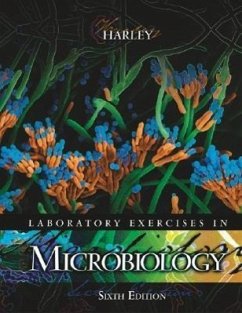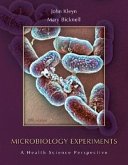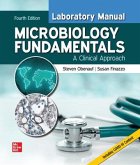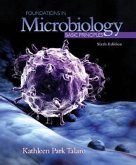- Broschiertes Buch
- Merkliste
- Auf die Merkliste
- Bewerten Bewerten
- Teilen
- Produkt teilen
- Produkterinnerung
- Produkterinnerung
"Laboratory Exercises in Microbiology, 6/e" has been prepared to accompany Prescott et al's "Microbiology, 6/e," Like the text, the laboratory manual provides a balanced introduction to laboratory techniques and principles that are important in each area of microbiology..
Andere Kunden interessierten sich auch für
![Microbiology Experiments: A Health Science Perspective Microbiology Experiments: A Health Science Perspective]() John KleynMicrobiology Experiments: A Health Science Perspective115,99 €
John KleynMicrobiology Experiments: A Health Science Perspective115,99 €![Annual Editions: Microbiology [With Access Code] Annual Editions: Microbiology [With Access Code]]() Govindan BrindaAnnual Editions: Microbiology [With Access Code]63,99 €
Govindan BrindaAnnual Editions: Microbiology [With Access Code]63,99 €![Bacterial Lenses Bacterial Lenses]() David Medina CruzBacterial Lenses17,99 €
David Medina CruzBacterial Lenses17,99 €![PIONEERS IN MICROBIOLOGY PIONEERS IN MICROBIOLOGY]() King-Thom Chung & Jong-Kang LiuPIONEERS IN MICROBIOLOGY55,99 €
King-Thom Chung & Jong-Kang LiuPIONEERS IN MICROBIOLOGY55,99 €![The Microbiology of the Atmosphere The Microbiology of the Atmosphere]() Philip Herries GregoryThe Microbiology of the Atmosphere26,99 €
Philip Herries GregoryThe Microbiology of the Atmosphere26,99 €![Laboratory Manual for Microbiology Fundamentals: A Clinical Approach Laboratory Manual for Microbiology Fundamentals: A Clinical Approach]() Steven ObenaufLaboratory Manual for Microbiology Fundamentals: A Clinical Approach117,99 €
Steven ObenaufLaboratory Manual for Microbiology Fundamentals: A Clinical Approach117,99 €![Foundations in Microbiology Foundations in Microbiology]() Kathleen Park TalaroFoundations in Microbiology151,99 €
Kathleen Park TalaroFoundations in Microbiology151,99 €-
-
-
"Laboratory Exercises in Microbiology, 6/e" has been prepared to accompany Prescott et al's "Microbiology, 6/e," Like the text, the laboratory manual provides a balanced introduction to laboratory techniques and principles that are important in each area of microbiology..
Hinweis: Dieser Artikel kann nur an eine deutsche Lieferadresse ausgeliefert werden.
Hinweis: Dieser Artikel kann nur an eine deutsche Lieferadresse ausgeliefert werden.
Produktdetails
- Produktdetails
- Verlag: McGraw Hill LLC
- Revised
- Seitenzahl: 480
- Erscheinungstermin: Februar 2004
- Englisch
- Abmessung: 274mm x 220mm x 14mm
- Gewicht: 962g
- ISBN-13: 9780072556803
- ISBN-10: 0072556803
- Artikelnr.: 21940763
- Herstellerkennzeichnung
- Libri GmbH
- Europaallee 1
- 36244 Bad Hersfeld
- gpsr@libri.de
- Verlag: McGraw Hill LLC
- Revised
- Seitenzahl: 480
- Erscheinungstermin: Februar 2004
- Englisch
- Abmessung: 274mm x 220mm x 14mm
- Gewicht: 962g
- ISBN-13: 9780072556803
- ISBN-10: 0072556803
- Artikelnr.: 21940763
- Herstellerkennzeichnung
- Libri GmbH
- Europaallee 1
- 36244 Bad Hersfeld
- gpsr@libri.de
John Harley teaches Anatomy & Physiology and General Biology at Eastern Kentucky University, Richmond, KY and is also co-author of Prescott/Harley/Klein Microbiology and the ASM Microbial Telecourse Study Guide.
1 Microscopic Techniques 1 Bright-Field Light Microscope and Microscopic
Measurement of Organisms 2 The Hanging Drop Slide and Bacterial Motility 3
Dark-Field Light Microscope 4 Phase-Contrast Light Microscope 5
Flourescence Microscope 2 Bacterial Morphology and Staining 6 Negative
Staining 7 Smear Preparation and Simple Staining 8 Gram Stain 9 Acid-Fast
Staining (Ziehl-Neelsen and Kinyoun) Procedures 10 Endospore Staining
(Schaeffer-Fulton or Wirtz-Conklin) 11 Capsule Staining 12 Flagella
Staining: West and Difco's SpotTest Methods 3 Basic Laboratory and Culture
Techniques 13 Microbiological Culture Media Preparation and Sterilization
14 Culture Transfer Instruments, Techniques, and Isolation and Maintenance
of Pure Cultures 15 Spread-Plate Technique 16 The Streak-Plate Technique
and Different Media 17 Pour-Plate Technique 18 Cultivation of Anaerobic
Bacteria 19 Determination of Bacterial Numbers 4 Biochemical Activities of
Bacteria 20 Carbohydrates I: Fermentation and B-Galactosidase Activity 21
Carbohydrates II: Triple Sugar Iron Agar Tests 22 Carbohydrates III: Starch
Hydrolysis 23 Lipids: Lipid Hydrolysis 24 Proteins, Amino Acids, and
Enzymes I: Hydrogen Sulfide Production and Motility 25 Proteins, Amino
Acids, and Enzymes II: The IMViC Tests 26 Proteins, Amino Acids, and
Enzymes III: Casein Hydrolysis 27 Proteins, Amino Acids, and Enzymes IV:
Gelatin Hydrolysis 28 Proteins, Amino Acids, and Enzymes V: Catalase
Activity 29 Proteins, Amino Acids, and Enzymes VI: Coagulase and DNase
Activity 30 Proteins, Amino Acids, and Enzymes VII: Oxidase Test 31
Proteins, Amino Acids, and Enzymes VIII: Urease Activity 32 Proteins, Amino
Acids, and Enzymes IX: Lysine and Ornithine Decarboxylase Test 33 Proteins,
Amino Acids, and Enzymes X: Phenylalanine Deamination 34 Proteins, Amino
Acids, and Enzymes XI: Nitrate Reduction 5 Rapid Multitest Systems 35 The
API 20E System 36 The Enterotube II System 6 Unknown Identification 37
Using the First Edition of Bergey's Manual of Systematic Bacteriology to
Identify Bacteria 38 General Unknown 7 Environmental Factors Affecting
Growth of Microorganisms 39 Temperature 40 pH 41 Osmotic Pressure 42 The
Effects of Chemical Agents on Bacteria I: Disinfectants 43 The Effects of
Chemical Agents on Bacteria II: Antimicrobial Agents (Kirby-Bauer Method)
44 Hand Washing, Environmental Sampling, and Microbiological Monitoring 45
Determination of a Bacterial Growth Curve: Classical and Two-Hour Methods 8
Environmental and Food Microbiology 46 Standard Coliform Most Probably
Number (MPN)Test and Presence-Absence Coliform Test 47 Membrane Filter
Technique for Coliform and Fecal Streptococci; KONFIRM Test for Fecal
Coliforms 48 Isolation of Escherichia coli Bacteriophages from Sewage and
Determining Bacteriophage Titers 49 Enumeration of Soil Microorganisms 50
Bacterial Count of a Food Product 51 Examination of Milk for Bacteria 9
Medical Microbiology 52 Agglutination Reactions: Blood Groups 53 Isolation
of Normal Microbiota from the Human Body 54 Staphylococci 55 Pneumococci 56
Streptococci 57 Neisseriae 58 Aerobic and Anaerobic Endospore-Forming
Bacteria 10 Survey of Selected Eucaryotic Microorganisms 59 Fungi I: Yeasts
60 Fungi II: Phycomycetes, Ascomycetes, and Basidiomycetes 11 Microbial
Genetics and Genomics 61 Bacterial Mutation 62 Bacterial Transformation 63
Bacterial Conjugation: The Transfer of Antibiotic-Resistant Plasmids 64
Isolation of Genomic DNA from Saccharomyces cerevisiae 65 Isolation and
Purification of Genomic DNA from Escherichia coli 66 Identifying Archaea
and Bacteria Using the Internet and Computer-Assisted Gene Analysis
Appendix A Dilutions with Sample Problems Appendix B Metric and English
Measurement Equivalents Appendix C Transmission-Absorbance Table for
Spectrophotometry Appendix D Logarithms Appendix E pH and pH Indicators
Appendix F Scientific Notation Appendix G Identification Charts Appendix H
Reagents, Solutions, Stains, and Tests Appendix I Culture Media Appendix J
Sources and Maintenance of Microbiological Stock Cultures
Measurement of Organisms 2 The Hanging Drop Slide and Bacterial Motility 3
Dark-Field Light Microscope 4 Phase-Contrast Light Microscope 5
Flourescence Microscope 2 Bacterial Morphology and Staining 6 Negative
Staining 7 Smear Preparation and Simple Staining 8 Gram Stain 9 Acid-Fast
Staining (Ziehl-Neelsen and Kinyoun) Procedures 10 Endospore Staining
(Schaeffer-Fulton or Wirtz-Conklin) 11 Capsule Staining 12 Flagella
Staining: West and Difco's SpotTest Methods 3 Basic Laboratory and Culture
Techniques 13 Microbiological Culture Media Preparation and Sterilization
14 Culture Transfer Instruments, Techniques, and Isolation and Maintenance
of Pure Cultures 15 Spread-Plate Technique 16 The Streak-Plate Technique
and Different Media 17 Pour-Plate Technique 18 Cultivation of Anaerobic
Bacteria 19 Determination of Bacterial Numbers 4 Biochemical Activities of
Bacteria 20 Carbohydrates I: Fermentation and B-Galactosidase Activity 21
Carbohydrates II: Triple Sugar Iron Agar Tests 22 Carbohydrates III: Starch
Hydrolysis 23 Lipids: Lipid Hydrolysis 24 Proteins, Amino Acids, and
Enzymes I: Hydrogen Sulfide Production and Motility 25 Proteins, Amino
Acids, and Enzymes II: The IMViC Tests 26 Proteins, Amino Acids, and
Enzymes III: Casein Hydrolysis 27 Proteins, Amino Acids, and Enzymes IV:
Gelatin Hydrolysis 28 Proteins, Amino Acids, and Enzymes V: Catalase
Activity 29 Proteins, Amino Acids, and Enzymes VI: Coagulase and DNase
Activity 30 Proteins, Amino Acids, and Enzymes VII: Oxidase Test 31
Proteins, Amino Acids, and Enzymes VIII: Urease Activity 32 Proteins, Amino
Acids, and Enzymes IX: Lysine and Ornithine Decarboxylase Test 33 Proteins,
Amino Acids, and Enzymes X: Phenylalanine Deamination 34 Proteins, Amino
Acids, and Enzymes XI: Nitrate Reduction 5 Rapid Multitest Systems 35 The
API 20E System 36 The Enterotube II System 6 Unknown Identification 37
Using the First Edition of Bergey's Manual of Systematic Bacteriology to
Identify Bacteria 38 General Unknown 7 Environmental Factors Affecting
Growth of Microorganisms 39 Temperature 40 pH 41 Osmotic Pressure 42 The
Effects of Chemical Agents on Bacteria I: Disinfectants 43 The Effects of
Chemical Agents on Bacteria II: Antimicrobial Agents (Kirby-Bauer Method)
44 Hand Washing, Environmental Sampling, and Microbiological Monitoring 45
Determination of a Bacterial Growth Curve: Classical and Two-Hour Methods 8
Environmental and Food Microbiology 46 Standard Coliform Most Probably
Number (MPN)Test and Presence-Absence Coliform Test 47 Membrane Filter
Technique for Coliform and Fecal Streptococci; KONFIRM Test for Fecal
Coliforms 48 Isolation of Escherichia coli Bacteriophages from Sewage and
Determining Bacteriophage Titers 49 Enumeration of Soil Microorganisms 50
Bacterial Count of a Food Product 51 Examination of Milk for Bacteria 9
Medical Microbiology 52 Agglutination Reactions: Blood Groups 53 Isolation
of Normal Microbiota from the Human Body 54 Staphylococci 55 Pneumococci 56
Streptococci 57 Neisseriae 58 Aerobic and Anaerobic Endospore-Forming
Bacteria 10 Survey of Selected Eucaryotic Microorganisms 59 Fungi I: Yeasts
60 Fungi II: Phycomycetes, Ascomycetes, and Basidiomycetes 11 Microbial
Genetics and Genomics 61 Bacterial Mutation 62 Bacterial Transformation 63
Bacterial Conjugation: The Transfer of Antibiotic-Resistant Plasmids 64
Isolation of Genomic DNA from Saccharomyces cerevisiae 65 Isolation and
Purification of Genomic DNA from Escherichia coli 66 Identifying Archaea
and Bacteria Using the Internet and Computer-Assisted Gene Analysis
Appendix A Dilutions with Sample Problems Appendix B Metric and English
Measurement Equivalents Appendix C Transmission-Absorbance Table for
Spectrophotometry Appendix D Logarithms Appendix E pH and pH Indicators
Appendix F Scientific Notation Appendix G Identification Charts Appendix H
Reagents, Solutions, Stains, and Tests Appendix I Culture Media Appendix J
Sources and Maintenance of Microbiological Stock Cultures
1 Microscopic Techniques 1 Bright-Field Light Microscope and Microscopic
Measurement of Organisms 2 The Hanging Drop Slide and Bacterial Motility 3
Dark-Field Light Microscope 4 Phase-Contrast Light Microscope 5
Flourescence Microscope 2 Bacterial Morphology and Staining 6 Negative
Staining 7 Smear Preparation and Simple Staining 8 Gram Stain 9 Acid-Fast
Staining (Ziehl-Neelsen and Kinyoun) Procedures 10 Endospore Staining
(Schaeffer-Fulton or Wirtz-Conklin) 11 Capsule Staining 12 Flagella
Staining: West and Difco's SpotTest Methods 3 Basic Laboratory and Culture
Techniques 13 Microbiological Culture Media Preparation and Sterilization
14 Culture Transfer Instruments, Techniques, and Isolation and Maintenance
of Pure Cultures 15 Spread-Plate Technique 16 The Streak-Plate Technique
and Different Media 17 Pour-Plate Technique 18 Cultivation of Anaerobic
Bacteria 19 Determination of Bacterial Numbers 4 Biochemical Activities of
Bacteria 20 Carbohydrates I: Fermentation and B-Galactosidase Activity 21
Carbohydrates II: Triple Sugar Iron Agar Tests 22 Carbohydrates III: Starch
Hydrolysis 23 Lipids: Lipid Hydrolysis 24 Proteins, Amino Acids, and
Enzymes I: Hydrogen Sulfide Production and Motility 25 Proteins, Amino
Acids, and Enzymes II: The IMViC Tests 26 Proteins, Amino Acids, and
Enzymes III: Casein Hydrolysis 27 Proteins, Amino Acids, and Enzymes IV:
Gelatin Hydrolysis 28 Proteins, Amino Acids, and Enzymes V: Catalase
Activity 29 Proteins, Amino Acids, and Enzymes VI: Coagulase and DNase
Activity 30 Proteins, Amino Acids, and Enzymes VII: Oxidase Test 31
Proteins, Amino Acids, and Enzymes VIII: Urease Activity 32 Proteins, Amino
Acids, and Enzymes IX: Lysine and Ornithine Decarboxylase Test 33 Proteins,
Amino Acids, and Enzymes X: Phenylalanine Deamination 34 Proteins, Amino
Acids, and Enzymes XI: Nitrate Reduction 5 Rapid Multitest Systems 35 The
API 20E System 36 The Enterotube II System 6 Unknown Identification 37
Using the First Edition of Bergey's Manual of Systematic Bacteriology to
Identify Bacteria 38 General Unknown 7 Environmental Factors Affecting
Growth of Microorganisms 39 Temperature 40 pH 41 Osmotic Pressure 42 The
Effects of Chemical Agents on Bacteria I: Disinfectants 43 The Effects of
Chemical Agents on Bacteria II: Antimicrobial Agents (Kirby-Bauer Method)
44 Hand Washing, Environmental Sampling, and Microbiological Monitoring 45
Determination of a Bacterial Growth Curve: Classical and Two-Hour Methods 8
Environmental and Food Microbiology 46 Standard Coliform Most Probably
Number (MPN)Test and Presence-Absence Coliform Test 47 Membrane Filter
Technique for Coliform and Fecal Streptococci; KONFIRM Test for Fecal
Coliforms 48 Isolation of Escherichia coli Bacteriophages from Sewage and
Determining Bacteriophage Titers 49 Enumeration of Soil Microorganisms 50
Bacterial Count of a Food Product 51 Examination of Milk for Bacteria 9
Medical Microbiology 52 Agglutination Reactions: Blood Groups 53 Isolation
of Normal Microbiota from the Human Body 54 Staphylococci 55 Pneumococci 56
Streptococci 57 Neisseriae 58 Aerobic and Anaerobic Endospore-Forming
Bacteria 10 Survey of Selected Eucaryotic Microorganisms 59 Fungi I: Yeasts
60 Fungi II: Phycomycetes, Ascomycetes, and Basidiomycetes 11 Microbial
Genetics and Genomics 61 Bacterial Mutation 62 Bacterial Transformation 63
Bacterial Conjugation: The Transfer of Antibiotic-Resistant Plasmids 64
Isolation of Genomic DNA from Saccharomyces cerevisiae 65 Isolation and
Purification of Genomic DNA from Escherichia coli 66 Identifying Archaea
and Bacteria Using the Internet and Computer-Assisted Gene Analysis
Appendix A Dilutions with Sample Problems Appendix B Metric and English
Measurement Equivalents Appendix C Transmission-Absorbance Table for
Spectrophotometry Appendix D Logarithms Appendix E pH and pH Indicators
Appendix F Scientific Notation Appendix G Identification Charts Appendix H
Reagents, Solutions, Stains, and Tests Appendix I Culture Media Appendix J
Sources and Maintenance of Microbiological Stock Cultures
Measurement of Organisms 2 The Hanging Drop Slide and Bacterial Motility 3
Dark-Field Light Microscope 4 Phase-Contrast Light Microscope 5
Flourescence Microscope 2 Bacterial Morphology and Staining 6 Negative
Staining 7 Smear Preparation and Simple Staining 8 Gram Stain 9 Acid-Fast
Staining (Ziehl-Neelsen and Kinyoun) Procedures 10 Endospore Staining
(Schaeffer-Fulton or Wirtz-Conklin) 11 Capsule Staining 12 Flagella
Staining: West and Difco's SpotTest Methods 3 Basic Laboratory and Culture
Techniques 13 Microbiological Culture Media Preparation and Sterilization
14 Culture Transfer Instruments, Techniques, and Isolation and Maintenance
of Pure Cultures 15 Spread-Plate Technique 16 The Streak-Plate Technique
and Different Media 17 Pour-Plate Technique 18 Cultivation of Anaerobic
Bacteria 19 Determination of Bacterial Numbers 4 Biochemical Activities of
Bacteria 20 Carbohydrates I: Fermentation and B-Galactosidase Activity 21
Carbohydrates II: Triple Sugar Iron Agar Tests 22 Carbohydrates III: Starch
Hydrolysis 23 Lipids: Lipid Hydrolysis 24 Proteins, Amino Acids, and
Enzymes I: Hydrogen Sulfide Production and Motility 25 Proteins, Amino
Acids, and Enzymes II: The IMViC Tests 26 Proteins, Amino Acids, and
Enzymes III: Casein Hydrolysis 27 Proteins, Amino Acids, and Enzymes IV:
Gelatin Hydrolysis 28 Proteins, Amino Acids, and Enzymes V: Catalase
Activity 29 Proteins, Amino Acids, and Enzymes VI: Coagulase and DNase
Activity 30 Proteins, Amino Acids, and Enzymes VII: Oxidase Test 31
Proteins, Amino Acids, and Enzymes VIII: Urease Activity 32 Proteins, Amino
Acids, and Enzymes IX: Lysine and Ornithine Decarboxylase Test 33 Proteins,
Amino Acids, and Enzymes X: Phenylalanine Deamination 34 Proteins, Amino
Acids, and Enzymes XI: Nitrate Reduction 5 Rapid Multitest Systems 35 The
API 20E System 36 The Enterotube II System 6 Unknown Identification 37
Using the First Edition of Bergey's Manual of Systematic Bacteriology to
Identify Bacteria 38 General Unknown 7 Environmental Factors Affecting
Growth of Microorganisms 39 Temperature 40 pH 41 Osmotic Pressure 42 The
Effects of Chemical Agents on Bacteria I: Disinfectants 43 The Effects of
Chemical Agents on Bacteria II: Antimicrobial Agents (Kirby-Bauer Method)
44 Hand Washing, Environmental Sampling, and Microbiological Monitoring 45
Determination of a Bacterial Growth Curve: Classical and Two-Hour Methods 8
Environmental and Food Microbiology 46 Standard Coliform Most Probably
Number (MPN)Test and Presence-Absence Coliform Test 47 Membrane Filter
Technique for Coliform and Fecal Streptococci; KONFIRM Test for Fecal
Coliforms 48 Isolation of Escherichia coli Bacteriophages from Sewage and
Determining Bacteriophage Titers 49 Enumeration of Soil Microorganisms 50
Bacterial Count of a Food Product 51 Examination of Milk for Bacteria 9
Medical Microbiology 52 Agglutination Reactions: Blood Groups 53 Isolation
of Normal Microbiota from the Human Body 54 Staphylococci 55 Pneumococci 56
Streptococci 57 Neisseriae 58 Aerobic and Anaerobic Endospore-Forming
Bacteria 10 Survey of Selected Eucaryotic Microorganisms 59 Fungi I: Yeasts
60 Fungi II: Phycomycetes, Ascomycetes, and Basidiomycetes 11 Microbial
Genetics and Genomics 61 Bacterial Mutation 62 Bacterial Transformation 63
Bacterial Conjugation: The Transfer of Antibiotic-Resistant Plasmids 64
Isolation of Genomic DNA from Saccharomyces cerevisiae 65 Isolation and
Purification of Genomic DNA from Escherichia coli 66 Identifying Archaea
and Bacteria Using the Internet and Computer-Assisted Gene Analysis
Appendix A Dilutions with Sample Problems Appendix B Metric and English
Measurement Equivalents Appendix C Transmission-Absorbance Table for
Spectrophotometry Appendix D Logarithms Appendix E pH and pH Indicators
Appendix F Scientific Notation Appendix G Identification Charts Appendix H
Reagents, Solutions, Stains, and Tests Appendix I Culture Media Appendix J
Sources and Maintenance of Microbiological Stock Cultures



![Annual Editions: Microbiology [With Access Code] Annual Editions: Microbiology [With Access Code]](https://bilder.buecher.de/produkte/26/26882/26882889m.jpg)




